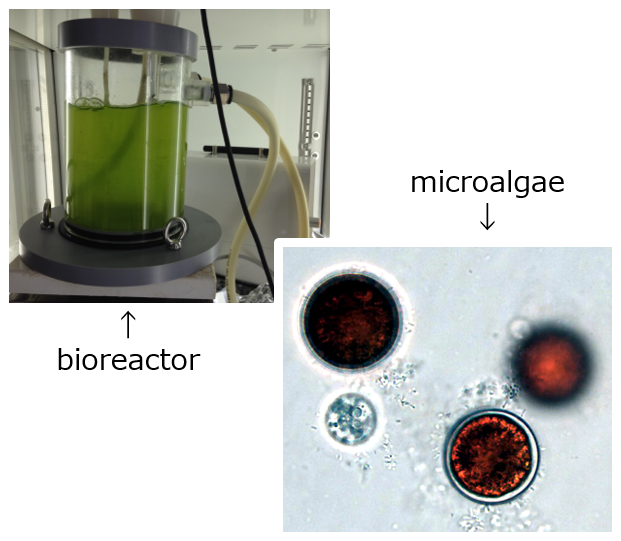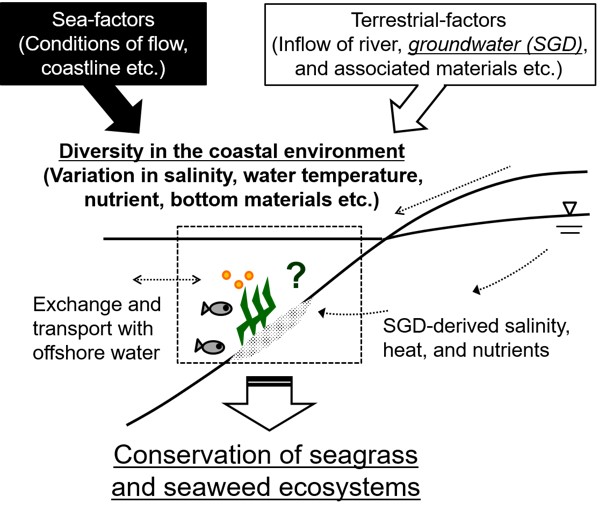Water Environment and Sanitation
Staff
Research Topics
“Water” is essential for our lives and livelihoods, and also works as a medium of transporting substances on both local and global scales. Therefore, the sustainability of our life and ecosystem can be easily threatened by the excess usage and pollution of water resources.
We are doing education and researches on “water quality control technology (water treatment)” and “relationship between material transport and aquatic ecosystems” to solve or prevent such issues for water resources. We hope to make our society safe, comfortable, and sustainable.
Wastewater to food production: A new wastewater treatment process
|
In the future world with more increased population, we will need more food and fertilizer. |

|
Evaluation of the groundwater function for conservation of coastal ecosystems
|
Seagrass and seaweed meadows are regarded as an important coastal ecosystem for their functions of “ecosystem service”, such as carbon stock and habitats. |

|
Publication List
- Nagare, H., Nomura, Y., Nakanishi, K., Akao, S. and Fujiwara, T.: Characterization of Effluent Water Quality from Hydroponic Cultivation System, J. Water Environ. Technol. Vol. 19, No. 2, pp. 64-73, 2021.
- Nagare, H., Iwata, T., Ebi, A., Akao, S., Maeda, M., Yasutake, D. and Fujiwara, T.: Simultaneous recovery of phosphorus and potassium from biomass as magnesium salt, 土木学会論文集G(環境). Vol. 76, No. 7, pp. III_181-III_187, 2020.
- Akao, S., Yasutake, D., Kondo, K., Nagare, H., Maeda, M. and Fujiwara, T.: Effects of cultivation period on catch crop chemical composition and potential for bioenergy production, Industrial Crops and Products. Vol. 111, No. 787-793, 2018.
- 永禮英明, 渡辺諒, 藤原拓, 赤尾聡史 and 前田守弘: 大型水生植物からのリン回収, 土木学会論文集G(環境). Vol. 72, No. 8, pp. III_249-III_254, 2016.
- Sato, H., Nagare, H., Huynh, T. N. and Komatsu, H.: Development of a new wastewater treatment process for resource recovery of carotenoids, Wat Sci Tech. Vol. 72, No. 7, pp. 1191-1197, 2015.
- Saito, M., Okuda, N. & Onodera, S. I., Material transport and cycle in watersheds: toward the interdisciplinary collaboration between limnology and the other research disciplines, Limnology, 21(3), 427-428, 2020.
- Ye, Z., Chen, J., Gao, L., Liang, Z., Li, S., Li, R., Jin, G., Shimizu, Y., Onodera, S. I., Saito, M. & Gopalakrishnan, G., 210Pb dating to investigate the historical variations and identification of different sources of heavy metal pollution in sediments of the Pearl River Estuary, Southern China, Marine Pollution Bulletin, 150, https://doi.org/10.1016/j.marpolbul.2019.110670 , 2020.
- Zhu, A., Saito, M., Onodera, S. I., Shimizu, Y., Jin, G., Ohta, T. & Chen, J., Evaluation of the spatial distribution of submarine groundwater discharge in a small island scale using the 222Rn tracer method and comparative modeling, Marine Chemistry, 209(11), 25-35, 2019.
- Saito, M., Onodera, S. I., Jin, G., Shimizu, Y. & Taniguchi, M., Nitrogen dynamics in a highly urbanized coastal area of western Japan: impact of sewage-derived loads, Progress in Earth and Planetary Science, 5(1), https://doi.org/10.1186/s40645-018-0177-6 , 2018.
- Saito, M., Onodera, S., Okubo, K., Takagi, S., Maruyama, Y., Jin, G. & Shimizu, Y., Effects of physical and morphometric factors on nutrient removal properties in agricultural ponds, Water Science and Technology, 72(12), 2187-2193, 2015.